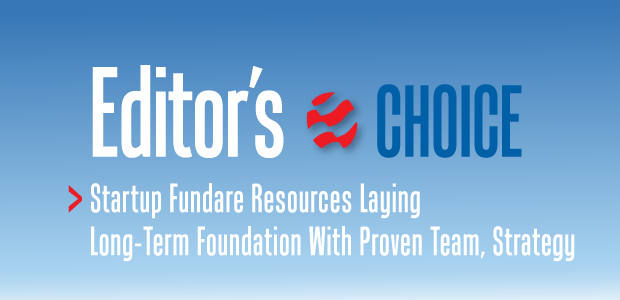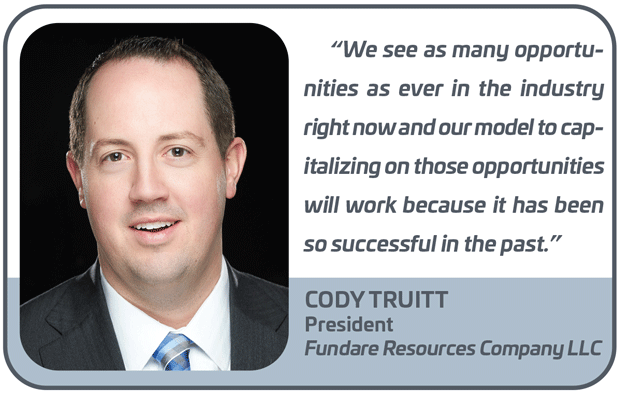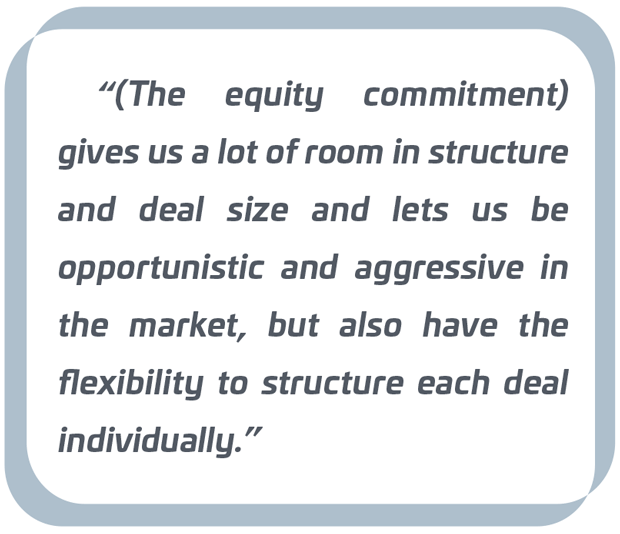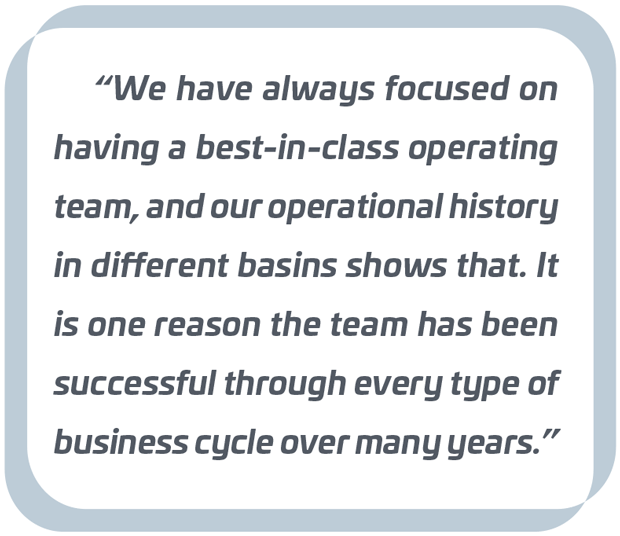
Special Feature
Startup Fundare Resources Laying Foundation With Proven Team and Strategy
By Tim Beims
DENVER–The oil and gas food chain is regenerative. Mergers or acquisitions at the upper end of the chain tend to churn out of the wash new links–often cast of familiar elements reconstituted from the M&A spin cycle–somewhere down the line.
A case in point is Fundare Resources Company LLC, formed by managing partners Mike Starzer and Pat Graham. If those names ring familiar, they should. They were the principals behind the Bonanza Creek/Fifth Creek lineage of operating entities. Bonanza Creek was founded in 1999 at the bottom of a commodity price cycle, seizing on the opportunity to grab top-end assets at lower-end price points in the Denver-Julesburg Basin. Over the next two decades, five successive generations of Creek companies collectively returned $2.46 billion of aggregate value on a total equity investment of $753 million, achieving an average 39% internal rate of return.
To state the obvious, Starzer and Graham know a thing or two about cultivating value in upstream oil and gas. They built their careers on a simple but effective strategy: take a contrarian approach of buying when the market is in sell-off mode, and then apply disciplined management and world-class operations and engineering to produce economic upside. It was a formula they successfully repeated time and again with the Creek companies, the last iteration of which–Fifth Creek Energy–was merged with Bill Barrett Corp. in 2018 to create HighPoint Resources.
But it was not long after Starzer and Graham had cashed in their Creek chips that they began seeing asset acquisition opportunities re-emerge. Then last spring came a downturn of historic proportions. They watched in disbelief as the pandemic created both personal and professional hardships for their former colleagues and peers, but they also knew all the turmoil would pass, as it always does in a cyclical business. Out of it would come recovery and renewal–and opportunity.
Long story short, two years was enough of a retirement. It was time to get back in the game in a market that was temporarily down, but certainly not out. “The oil and gas businesses is in their blood. They love it and believe in its long-term importance,” says Cody Truitt, who had been on the executive team at Bonanza Creek/Fifth Creek and came back alongside the principals in February as Fundare’s president.
“They love pursuing opportunities and being around the team day to day,” he continues. “This also is a chance to grow another good company that enriches other peoples’ lives; not just employees, but the community as well. Philanthropy is a big part of why they do what they do.”
So, last summer the two industry veterans quietly crafted a proposed business plan for a new startup entity at a time when all the talk in the industry was of consolidations, shut-ins and write-downs. What they came up with was a tried-and-true approach for Fundare Resources that harkens back to the future, replicating a similar “buy at the bottom” strategy in the same basins with many of the same key personnel deploying the same essential operational principles and even the same capital private equity backing as in the early days of the Creek companies.
“We see as many opportunities as ever in this industry right now. There are excellent assets out there for the right team,” Truitt adds. “We know our model to capitalizing on those opportunities will work because it has been so successful in the past. All five Creek companies are proof of that.”
Business Thesis
The severe market disruptions that occurred last year rippled throughout every aspect of the business, from corporate boardrooms all the way down to the asset level in the same legacy basins where Starzer, Graham and Truitt had cut their management teeth and developed a small private independent into a public company with industry-leading financial metrics.
“The market came under a lot of stress last year, but owners were reluctant to sell assets at such low valuations. We are seeing a rising tide in commodity prices, and that should help bridge the bid-ask gap on properties,” Truitt explains. “We are definitely seeing good opportunities to invest in low-risk, high-quality assets that will let us grow through both development and commodity price upside. That is a key part of our business thesis.”
Another aspect relates to the geographic locations of the management team’s deep operational background, dating to Starzer and Graham’s days working in Alaska and California, and then collaborating with Truitt to successively build the Creek companies with a focus on the Rockies. Truitt had served in engineering and business development roles at Fifth Creek and its predecessor Bonanza Creek companies.
“We are pursuing investments in basins in states that are considered ‘unfavorable’ for oil and gas development, such as Colorado and California.” Truitt details. “Our investor group is not opposed to those states given our history of owning and operating assets there, and the fact that we have made good money in those basins over the years. We are comfortable in these states because we know how to operate there successfully.”
A third element of the strategy is capital formation acumen. Truitt points out that the Creek companies used a variety of financial sources, including private equity, mezzanine, public equity, bank debt, reserves-based credit facilities and joint ventures. Here again, Fundare is charting its course forward by going back to what worked so well in the past. In February, the company announced commitments from Woodward Diversified Capital, the same family-owned private equity investment group that had backed Bonanza Creek through its early stages.
At the time of the announcement, Starzer commented, “We are pleased to be working again with the outstanding team at WDC as we build Fundare into another successful acquisition and development company. I look forward to repeating the success of the past five Creek companies with WDC.”
Beau Woodward, managing partner at WDC, stated, “In their operational and leadership roles at the previous Creek companies, (Truitt, Starzer and Graham) demonstrated their ability to acquire and develop assets in varied market conditions with exceptional returns for their investors. We look forward to working with them and the entire Fundare team.”
In addition to unveiling its partnership at startup with WDC, Fundare also announced last month that it had engaged independent investment banking firm Rivington Holdings to assist with raising additional capital and other financial advisory services related to acquisitions.
Built For Long Haul
One critical distinction between Fundare’s strategy and the business model of the Creek line of companies, which were established and sold in relatively quick succession, is the fact that Fundare is being built from scratch for the long haul, according to Truitt. Its very name, which in Latin translates to “laying a foundation,” reflects that fundamental redirection in philosophy.
“The idea is to build a long-term platform of assets, pursue multiple deals, and have the same management and technical teams operate the assets for a long period. That is important, because we believe we do a better job of operating properties than competitors, and our track record speaks to that,” he remarks. “We want to create something long lasting and grow Fundare with our investors over time.”
Truitt says the time-tested relationship with WDC, and the flexibility in the way the private equity placements will be structured, are both key to Fundare’s execution of its plan. “Our track record in generating good return profiles for the investor group, and the investors’ track record in supporting us in the past, were important in setting up the tenets of the commitment because it creates mutual trust,” he comments.
“Without sharing too much about the specifics, the equity commitment is on a club basis. It gives us a lot of room in structure and deal size and lets us be opportunistic and aggressive in the market, but also have the flexibility to structure each deal individually,” Truitt goes on.
As with the Creek companies, Fundare may eventually need to tap into mezzanine and term financing or other sources down the road, but Truitt says the private equity arrangement with WDC is the ideal solution for its early-stage development. “We have to be nimble in this environment and equitize our transactions right out of the gate,” he comments. “The commitment from WDC lets us get a deal done with one investor group and equitize that asset, and then work with another investor group to raise additional funding for the next deal and get it equitized.”
With all the components of the business strategy defined, the team in place, and the capital secured, the next crucial step in Fundare’s evolution is building a portfolio of assets. The value creation that flowed from putting the right properties in the capable hands of the operational team was demonstrated in case after case at the Creek companies, Truitt points out.
“We grew Bonanza Creek’s oil production from 4,000 to 25,000 bbl/d in short order, and in doing that, became the top-performing stock in the exploration and production sector in 2012. An example of that is the Dorcheat Macedonia Field in Arkansas. It was making 1,000 barrels of oil equivalent a day when we acquired it. We used pinpoint coiled-tubing conveyed fracturing technology to grow it to 6,000 boe/d.” he recalls. “Another example is the Hereford Field in the D-J Basin. It had been dormant for four years when we acquired it from EOG Resources. We applied modern horizontal well completion designs and improved well productivities and EURs dramatically.”
Acquisition Targets
U.S. activity and investment levels collapsed last year to historical low points, but an expected fire sale of assets did not happen. Truitt explains that was largely because buyers and sellers could not agree on valuations, and capital availability became ultratight. Thanks to oil prices climbing $20/bbl since December, the A&D landscape appears to be trending very differently than it was only one business quarter ago. Will buyers and sellers come together to reach deals in 2021?
“I definitely think so,” Truitt responds. “Most of the deals transacted have been on a proved, developed producing reserve risking basis with very little value for undeveloped potential. With the recent rise in commodity prices, we are getting closer to the bid-ask prices coming into alignment. Time will tell, but we have started seeing new deals appear within just the past few weeks that had stayed on the sidelines in 2020, and some deals that launched last year but did not attract acceptable bids are also starting to come back around.”
What would an ideal first asset acquisition target look like? To start, it would have to be heavily weighted toward PDP reserves and offer low risk with the ability to generate immediate cash flows and return a minimum 8% yield over 10 years, according to Truitt.
“We are agnostic about whether an asset produces oil or gas. We are focused on chasing PDPs within our proven areas of operating expertise, and will stick to repeatable, low-risk development opportunities that are associated with highly leveraged PDP transactions,” he says. “But we are not going to buy PDP assets and sit on them. We need undeveloped locations because we will be looking to pivot to drilling and completion projects to create a ton of high-growth upside.”
In addition, he says Fundare will seek to “check the boxes” for mature infrastructure to provide opportunities to achieve scale, and identifiable opportunities to optimize production operations, reduce general and administrative costs and operating expenditures, optimize midstream contracts, etc.
Truitt reiterates that Fundare’s search for the right properties will concentrate in basins off the beaten path. “Part of our strategy is to invest in areas that have not seen new investments in a while. Take Colorado for example. New money has not come into the state in a meaningful way in some time. A lot of the deals happening in Colorado are by companies already in the state and by capital backers leveraging up within the same basins,” he remarks. “We are not afraid of the regulatory environment in Colorado, and our operating history there just makes us all the more competitive.”
Once it closes in on a target, Truitt says Fundare will underwrite it to a strip deck and use various hedging instruments to assure stable cashflows and quarterly dividend yields regardless of commodity price volatility. “We are not built to flip, and we will not buy a property to bet on a sale at some multiple. We are in it as an asset owner and operator to generate dividends over a time frame of 10 years or longer. We want to grow sustainable value.”
Best-In-Class Operations
And that gets to the final piece in the Fundare business proposition: leveraging operational expertise and technology to find and fully extract upside value. “We have always focused on having a best-in-class operating team, and our operational history in different basins shows that. It is one reason the team has been successful through every type of business cycle over many years,” Truitt relates.
Completion and stimulation design is where Fundare’s core operational competencies really shine. “Once we acquire an asset, the key to our success will come down to innovation and applying technology, and that will focus mostly on using statistical analysis and advanced completion techniques to maximize production and recovery rates,” he offers.
“We are going to be in mature resource plays, in which there was still quite a bit of completion design experimentation and innovation going on for the last five or six years. There is so much more well control now and operators have tried so many different things that it allows us to leverage all that data using advanced methods to extract valuable insights and make better informed decisions when it comes to well spacing and completions,” Truitt says. “We are a firm believer in using data to innovate and fine-tune our fracturing and completion techniques.”
It is not merely about pumping better fracs and lowering OPEX, however. Fundare’s management approach seeks to optimize every aspect of a field’s operation, from production equipment run times to midstream contract negotiations.
“We are seeing a lot of deals with unfavorable midstream agreements attached to them. In those situations, there are opportunities to rework agreements,” says Truitt, who spent the two-and-a-half years between the merger of Fifth Creek and startup of Fundare serving as chief commercial officer at Cureton Midstream. “Negotiating more favorable midstream agreements will give us better netbacks along the way in these low-risk, long-lived producing properties.”
Each incremental step taken to improve operational performance goes a long way toward maximizing net asset value, Truitt says, and helps explain how the Creek companies were able to generate an average $3.30 return on every $1 invested between their initial founding in 1999 and exit in 2018.
“We are building Fundare the same way: a foundation of strong assets, best-in-class operations, and proven management principles that have resulted in repeated success,” he concludes. “We are excited to get out of the gate and begin executing our strategy and making our first deal.”
For other great articles about exploration, drilling, completions and production, subscribe to The American Oil & Gas Reporter and bookmark www.aogr.com.









